Warby Parker opens at $54.05 per share in public debut on NYSE, soaring more than 30% above reference price
The eyewear start-up Warby Parker made its public debut Wednesday, via a direct listing, at $54.05 per share, soaring more than 30% above a $40 reference price.
The stock closed at $54.49 during its first day of trading, climbing 36%. That gives the company a valuation of more than $6 billion, based on shares outstanding.
The stock is now trading on the New York Stock Exchange under the ticker symbol WRBY. The debut is testing investors’ appetite for a household direct-to-consumer retail name, as the company spearheaded a movement of other brands launching online first and bypassing wholesale.
Warby Parker joins names such as Spotify, Roblox and Coinbase that have also gone public through a direct listing, rather than an initial public offering. In a direct listing, a company doesn’t raise new capital from banks. Instead, it lists its shares on an exchange, and the shares begin trading at a price set through negotiation between the company and public investors. Insiders are then able to sell shares whenever they choose.
The NYSE set a reference price of $40 on Tuesday night based on previous trades on private markets, which gave the company a market value of about $4.5 billion. Ultimately, the publicly listed price was based on investor demand. Shares of the company had traded privately in April at $24.53, according to company filings.

When Warby Parker was founded in 2010, the company was initially sending customers glasses to try on at home and keep what they wanted to buy. The company has expanded by opening up stores, which has helped to balance out the hefty expenses that come with running a massive e-commerce operation. In 2019, it launched a line of daily contact lenses.
“We have less than 1% of market share in this massive category, and see huge tailwinds to grow our top line and our bottom line in the years to come,” Dave Gilboa, co-founder and co-CEO, said Wednesday on “Squawk Box.”
“There’s so much opportunity to scale our physical retail footprint but also scale our e-commerce offering,” he said.
In recent years, Warby Parker’s sales have grown but so have its losses. Its net revenue in the fiscal year that ended Dec. 31, 2020, grew to $393.7 million from $370.5 million in 2019, according to documents filed with the Securities and Exchange Commission.
Warby Parker broke even two years ago, but in 2020 its net loss totaled $55.9 million.
In recent months, Warby Parker has continued to lose money. It lost $7.3 million in the six months ended June 30.
One of the eyeglass maker’s largest investments in the coming years will be in bricks-and-mortar growth, which Warby Parker hopes will fuel earnings. While it forecasts revenue will keep growing, the company has yet to reveal when it might become profitable.
The company is planning to open 30 to 35 new stores by the end of fiscal 2021, bringing its total shop count to about 155 to 160 locations.
Although its stores were temporarily shut during the pandemic, Warby Parker has benefited from having a strong digital presence. Many consumers are still shopping more online. Roughly 50% of Warby Parker’s sales came from digital in the first six months of this year, according to the company’s filings, compared with 60% last year.
“Ultimately we don’t care where a customer transacts,” Gilboa said. “We just want to make sure that they have the best experience possible.”
Warby Parker is also looking to grow in categories beyond glasses. Last year, about 95% of its sales were glasses, while 2% came from contact lenses, 1% from eye exams and 2% from eyewear accessories.
Neil Blumenthal, co-founder and co-CEO, sees the chance to scale in those other categories.
“Contact lenses are 2% of our business, but it’s a $5 billion-plus market,” he said. “Same with eye exams … 1% of our business, but it’s also a $5 billion-plus [market] — massive opportunities for us in the future.”
For its fiscal third quarter that will end on Thursday, Warby Parker sees net revenue ranging between $131 million and $133 million, which would represent an increase of 26% to 28% from 2020 levels.
For the year, it expects sales to total $532 million to $537 million. In fiscal 2022, Warby Parker estimates, net revenue will rise at least 25% from the prior year.
In Warby Parker’s direct listing, registered stockholders will be able to sell 92.5 million Class A shares, but the company won’t receive any proceeds from those sales.
Warby Parker’s investors include Tiger Global Management, General Catalyst, Baillie Gifford and D1 Capital Partners.
Source: CNBC




